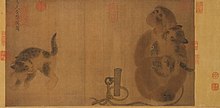|
Yi Yuanji Yi Yuanji (Chinese: 易元吉; Wade-Giles: I Yüan-chi) (c. 1000, Changsha, Hunan[1] – c. 1064) was a Northern Song dynasty painter, famous for his realistic paintings of animals. According to Robert van Gulik, Yi Yuanji's paintings of gibbons were particularly celebrated.[2] [3] The 11th-century critic Guo Ruoxu (郭若虚) in his Overview of Painting (图画见闻志, Tuhua Jian Wen Zhi) tells this about Yi's career:[4][5]
He spent months roaming the mountains of southern Hubei and northern Hunan, watching roebucks (獐鹿) and gibbons (猿狖) in their natural environment.[2]  In 1064, Yi Yuanji was invited to paint screens in the imperial palace. Once this job has been completed, the Yingzong Emperor, impressed, commissioned him to paint the Picture of a Hundred Gibbons, but the artist died after painting only a few gibbons.[1][2] A few of his other gibbon paintings have survived, and Robert van Gulik, quite familiar with the behavior of this ape, comments on how naturally they look in the pictures.[2] His other work includes depictions of deer, peacocks, birds-and-flowers and fruits-and-vegetables; many of them are kept in the National Palace Museum in Taipei.[1] The Monkey and Cats painting is especially charming.[6] Van Gulik identifies the monkey as a macaque.[2] This painting was featured on a 2004 "Year of the Monkey" stamp from Saint Vincent and the Grenadines.[7] The image of Yi Yuanji, with his intimate knowledge of nature, has attracted attention from modern Chinese painters.[8] ReferencesWikimedia Commons has media related to Yi Yuanji.
|
Portal di Ensiklopedia Dunia